Tombo by W.S. Di Piero
 Tombo
Tombo
by W.S. Di Piero
McSweeney’s Books, 2014
65 pages / $15 Buy from McSweeney’s
Tombo is a book about place as much as anything. It’s about San Francisco. Many poems are about place – whether they are explicit about it or not. Di Piero is explicit in Tombo. W.S. Di Piero recently won the Ruth Lilley Poetry Prize, a Guggenheim Fellowship, a National Endowment for the Arts Grant, the Lila Wallace-Readers Digest Award, and writes for the New York Times, among other places. He is an incredibly distinguished poet and McSweeney’s bills him as “a master of the adjective, a master of sound and story.”
I’d never read anything by W.S. Di Piero before this book, which I read primarily at cafes not in San Francisco. Di Piero starts the book by addressing, you, the reader, “Life, as you say, my friend, / is lived in its transitions.” Life is funny like that. The first poem, The Running Dog, involves a brunch I could envy “A breakfast of poached eggs, / spiked coffee, newsy talk, / crushed sun behind the clouds, / marine layer vapors phasing / blue to green, and the body / quivers through its days.” In fact, like living in San Francisco and eating brunch, there’s a lot about the life of the poet that seems enviable, depending on your disposition.
I would highly recommend this book if you appreciate poemy poems full of foghorns, flowers, and random interjections in other languages. Di Piero prides himself on sound and music, and there is a certain music in these poems – while they’re unrhymed free verse, there’s a recognizable rhythm and music throughout.
The poem Sleeping Potions reminds me of a story I heard from a local bike mechanic: A man came into his bike shop, and took a used bike out for a test-ride. The man never came back. He had left his bag with a laptop, credit cards, wallet, and other valuable things, at the bike shop as collateral / insurance. A few days later the bike shop gets a call. The police had found the man “several hundred miles” north of the bike shop – he had no explanation for what he had done – he didn’t know or remember the previous several days. The bike was returned to the shop and the man got his bag and valuables back. But what happened between the shop and hundreds of miles north?
And what’s happened in Tombo during the intervening fugue paragraph? We’ve moved from Hayes Street, to Duboce Triangle, to the N-Judah. We’ve got a look at Market and the Mission and Dolores Park. Di Piero has said that his books “start out as miscellanies.” The poems in Tombo don’t have the kind of narrative arc or grand teleological direction. They’re brief meditations. “If my poems come out right, they tell what it feels like to live in a world of troubled relatedness,” Di Piero said in an interview. I like this idea of troubled relatedness – and I think it’s an interesting way to talk about poems.
July 7th, 2014 / 10:00 am
The Parapornographic Manifesto by Carl-Michael Edenborg
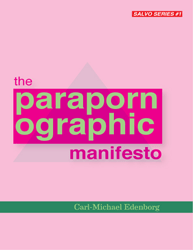 The Parapornographic Manifesto
The Parapornographic Manifesto
by Carl-Michael Edenborg
Action Books, 2013
38 pages / $8 Buy from Action Books or SPD
Author’s Note: This is a failed review. I think by definition you can’t really write a review of a manifesto. If you read a review of The Communist Manifesto or The Surrealist Manifesto how would it go? “A little dry, kind of pedantic, I wish there were more pictures?” Here Edenborg lays out some ground rules for a new category of pornography that, by the end of the work, aims to be a new critical and theoretical lens. Like other manifestos I think you can reject it, adopt it, or stand somewhere, critically, in the middle.
***
Commence regular review:
The Parapornographic Manifesto from Carl-Michael Edenborg is the first Salvo from Action Books, in I assume, a series of chapbook size manifestos or mini-treatises on theoretical or critical concerns. Over the course of the book Edenborg outlines some history of pornography and proposes the parapornographic as a thing that is not post- or anti- but some other more complicated, unclear, way of understanding the genre.
As far as Google is concerned, most of the discussion of Parapornography takes place at Montevidayo, which makes sense, since it is on Action Books, and bears something of a resemblance to the poetics as it were, of that website. The parapornographic of Edenborg exemplifies a kind of post-post-modernity, as far as I can tell. Where the goal/intention/desire isn’t rooted in furthering or transcending history, but a Deleuzean? Deleuzional? kind of entanglement – and alternative to teleological progression.
Frankly, I think it’s essential to ask about a concept like Parapornography whether it is necessary, essential, or most importantly, useful to understanding what it describes. Edenborg writes that while anti-pornography and post-pornography, and even, pornography pornography, can be parapornography; they don’t always make they cut:
“The Antipornographic-pornographic complex can be seen in itself a parapornographic phenomenon, filled with frightening pleasures.
The producers, distributors, and consumers of pornography and its critics – including the pornographic material in itself and the more or less violent, legal or extra-parliamentary attacks on it – form a machine that multiplies and turns bodies inside out. Only talking about the instrumentalization and objectification of people is not going far enough in the reflection: parapornography is strictly discursive and presupposes that the All arises as a bug in the game of emptinesses.”
Every Being is divided into a variety of instruments and objects in this game, her sides are finely ground and placed in four-dimensional machines that have a peculiarly autonomous function. Parapornography affirms this, by converting objectification into multiple fetishization.”
Edenborg outlines these features of what he called “the parapornographic technology”:
The infinity of revealing
The exploded affection theory
The critical will to power
The violent pollution
Protesology and displacement
I’ve been working on this review for weeks – and I’ve read the book several times, along with just about every single mention of it on the internet – and I still have no idea what “protesology” is. I can take a crack at “exploded affection theory” but that too isn’t defined in any way in the work or in any external place that I can find – and I assume to explode a theory of affection you’d have to have one first. Is protesology the –ology of protes, Swedish for prosthesis? I just don’t know.
Edenborg claims that, “The Nietzschean superman can be said to be the protagonist of the majority of all of pornography, both through his erect penis and his master’s gaze.” Parapornography must depart from the Nietzschean ubermensch. Edenborg says that one of the first parapornographic works comes by way of Guillaume Appolinaire in Les Onze Milles Verges in 1907. Apollinaire apparently edited a publishing house that published erotic literature – and Edenborg sees Les Onze Milles Verges as a kind of deconstruction / reconstitution of the pornographic – “pornography is ridiculed and affirmed in the same prismatizing motion.”
To answer the question I asked earlier, that parapornography is useful, and perhaps essential. I do not know whether it is our salvation, as Edenborg grandly puts it at the end of the Manifesto. I think that it can offer some important insights:
“To those who try to sell or protect a religious delusion such as the idea of ‘nudity,’ parapornography pushes its own revival: the insight in the limitlessness of unclothing, in non-Euclidean anatomy, in the darkness of excitement. That law creates desire means loneliness. The fact that those things that prevent desires also create our desires means loneliness. Consuming pornography or exciting oneself with antipornography means loneliness.”
“Against these solipsisms, parapornography proposes the absence of self.”
This proposition is not so different from the intention of some spiritual orders and some poetry – think of Emerson’s invisible eye-ball for a minute and you’ve got both covered. Of course, parapornography seems to come at ‘self-less-ness’ in a distinctly different way.
***
Leif Haven lives and writes in Oakland.
November 25th, 2013 / 12:00 pm
Light While There Is Light: An American History by Keith Waldrop
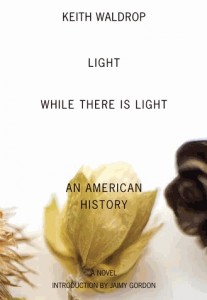 Light While There Is Light: An American History
Light While There Is Light: An American History
by Keith Waldrop
Dalkey Archive, 2013
220 pages / $14 Buy from Amazon or Dalkey Archive
“What I would like, I think, is to live a while longer. But not again.”
– Keith Waldrop
Light While There Is Light is called variously a fictional memoir, an autobiographical novel, and a masterpiece of twentieth century American fiction. I appreciate that the Dalkey Archive released it as Fiction. Somehow it feels better to call this a novel – and Waldrop seems to understand that. In reality I think that most readers assume a first person narrator should be equated with the author – what’s satisfying about this book is that it doesn’t seem to matter if you do or not. Despite the obvious allusions to the life of Keith Waldrop the person, and even the pictures that show Keith Waldrop the person in the text, this is a novel, not a memoir.
Compared to, say, Waldrop’s other work, this book is very accessible – readable even – and I’ve returned to it multiple times since receiving the book. I’ve enjoyed returning to it to go back and read a passage. It’s also illuminating (the book is full of light puns) to return and notice the kinds of motifs and themes that Waldrop uses throughout to create a kind of unified whole. It’s something that I would be happy to continue to read and reread, but also recommend that almost anyone read – It’s something that I’d recommend to friends, family members, writers, etc. There’s something to be learned from Waldrop’s sentences.
Despite what I would call a “straightforward” quality of the prose, every bit seems composed with intense attention to diction and pacing. It’s poetry, and it also bears poetry’s intense loyalty to peculiar internal logics:
Waldrop meanders through his own life thematically more than chronologically – though it does proceed in a relatively ordered fashion. Light Where There Is Light reminds me of W.G. Sebald’s books, and most specifically Rings of Saturn.
Both have the kind of detached, slightly melancholic, and drily humorous narrator, and easily shift from memory, to recollection, to reminiscence. There’s also the peculiar feeling that the narrator might not be trustworthy – or that the narrator might be fabricating half of the story (a kind of death of the author double bind, wherein the reader is trapped in the belief that at least the author is fabricating one story, instead of multiple layers of story) for the sake of symmetry or cohesion.
One anecdote, that Waldrop calls, “The spookiest story I ever heard,” near the beginning of the book, I actually wondered for a second if it was was from a book by Sebald – though I haven’t gone back to try to confirm or deny this suspicion. Not only was Light Where There is Light composed before Rings of Saturn, but it also seems completely irrelevant where the story comes from because it is so essential to this book., or at least to the understanding of the book. The little parable is so evocative – so essentially metaphorical and like a synecdoche for the whole work that it’s almost hard to believe that it’s anything but an invention of Waldrop’s.
The book starts as an origin story. It’s not really an origin story of Keith, the Narrator, but more like the beginning of the root cause of the series of family misadventures that form the book. The narrator’s own birth and conception remain obscure.
November 11th, 2013 / 11:00 am
I’m not leaving my bed in the gloom
 Fright Catalog
Fright Catalog
by Joseph Mosconi
Insert Blanc Press
100 pages / $24.99 Buy from Insert Blanc Press
Fright Catalog is a gorgeous, huge, glossy, expensive looking magazine. That makes it more fragile, more disposable than most books. I’ll probably put it on the wall when I’m done with this review. It’s also a work that you might carry around and show off. Or like something out of Borges, you might want to check in on the book to see if the words have mysteriously reshuffled into even more hideous koans.
Each page is a different visual/textual work, set in super large sans serif font centered on a brilliantly colored slightly glossy page. Mosconi is part of The Poetic Research Bureau, which “favors appropriations, impersonations, ‘compost’ poetries, belated conversations, unprintable jokes and doodles, ‘unoriginal’ literature, historical thefts and pastiche.“Based on that, you can imagine that the book is going to use some “mechanism” of unoriginality, in its creation, but the book itself doesn’t give it away. All you get is this:
“Each Stanza of Fright Catalog was fed through the search engine of an online Color Theme generator. A different color theme was determined for each stanza resulting in the color combination you see on each page of this book. Every color theme addresses your feelings and is employed for certain moral ends.”
A book like this doesn’t ask you to consider it as a project; it demands to be recognized as one. Sometimes that “chance” part of the project produces amusing/intuitive result (ie vampires get mentioned and you get a red/black color scheme) but it also hints that there is some other project going on with the text. Luckily, or unluckily, Craig Dworkin reveals the source of the text on the Insert Blanc site:
“Secrets, in these scenes, threaten to become singularities. Such, of course, is the reductio of all subcultures. And “Poetry,” for “Culture,” has become the ultimate and necessary subculture of them all. Fright Catalog is thus in part a dissertation on the sublime terror of the poetry scene today — with all its partisan scholasticism and stupid undergrounds (as Paul Mann would say). But this catalogue is also attuned to the poetic possibilities of subcultural discourse, to the phonemic tensions and narrative frissons that arise when metal lyrics are mashed up with phrases taken variously from online gaming dialogues, occult forums, and the secret language of adolescence (by definition: misunderstood; mardy; uncommunicative and inscrutable).”
That’s about half of the blurb. If you’re not keeping track of obscure metal from the past 20 years or so, then you might not notice that some of the more absurd (and startlingly beautiful) moments of this book are simply song titles. I think that the sublime terror can be read as a response to contemporary poetry, but sublime terror, a la Romanticism, or an inverted modernized terror/sublime, is also a major ingredient in metal and this work. Mosconi takes metal and other texts and distills something essential about terror and the sublime from them:
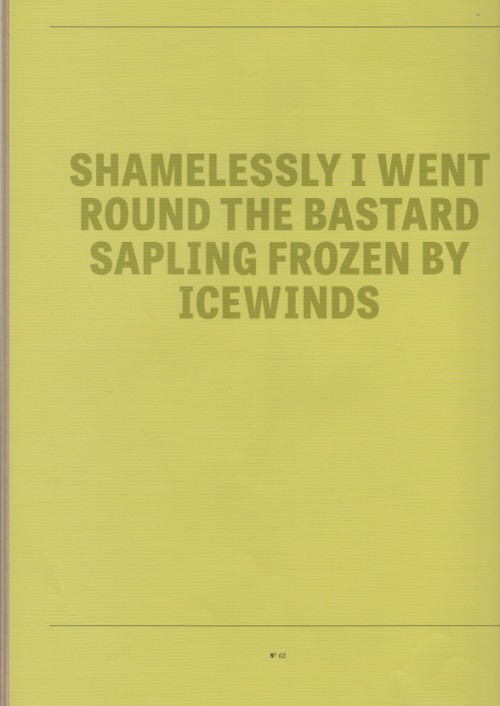
July 12th, 2013 / 11:00 am
Denotation Withered on the Vine
 154 Forties
154 Forties
by Jackson Mac Low
edited by Anne Tardos
Counterpath Press, October 2012
328 pages / $22 Buy from SPD or Amazon
Mac Low created this book of poems from 1990 to 1999, collecting and editing as he went. He claims to have only edited the caesural spaces; everything else written word after word, as they came to him. The poems feel completely strange and alien, but at the same time intimate; the challenging poems are both alienating and enthralling.
(I wonder if the writer or editor let practitioneer slip as a portmanteau of pioneer and practitioner.)
Mac Low participated in Fluxus, and his work, like other Fluxers, shows the requisite influence of Cage, Duchamp, and others. However, instead of the performance based art that Mac Low created for Fluxus:
Tree Movie
Select a tree* Set up and focus a movie camera so that the tree fills most of the picture. Turn on the camera and leave it on without moving it for any number of hours. If the camera is about to run out of film, substitute a camera with fresh film. The two cameras may be altered in this way any number of times. Sound recording equipment may be turned on simultaneously with the movie cameras. Beginning at any point in the film, any length of it may be projected at a showing. *for the word ‘tree’, one may substitute “mountain”, sea”, “flower”, “lake”, etc. January 1961 The Bronx (Found at artnotart.com fluxus debris)
Whereas art like this from his Fluxus days tends toward the conceptual, the poems in 154 Forties are lyrical. They are primarily concerned with immediacy and music. As a way of categorizing, where Tree Movie, above, is a performance for the future, in un-rhymed, unmetered prose, the Forties abandon grammar, syntax, indeed, denotation, and instead adopt abstract music. It works both ways; music is foregrounded because the sense has been, for the most part, left absent. The best demonstration of how these poems can be interpreted and performed can be found here at Counterpath Press. This project includes Mathias Svalina saying “colostomy falafel”, and an all-star lineup including K. Silem Muhammad, Lyn Hejinian, Paul Hoover, Douglas Kearney, Juliana Spahr, and HTML Giant’s own Janice Lee performing most of the Forties.
May 27th, 2013 / 11:00 am
FRAGILE KINGDOM
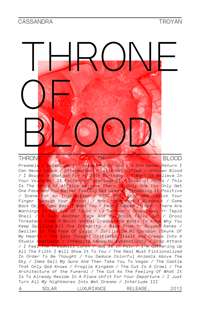 Throne of Blood
Throne of Blood
by Cassandra Troyan
Solar Luxuriance, February 2013
90 pages / $13 Pre-order from Solar Luxiariance
CHICKEN SALAD SANDWICH
CHICKEN SALAD SANDWICH
-Throne of Blood
Throne of Blood begins with a Preamble. The Preamble sets the tone for the book, just like the Preamble to the United States Constitution is a brief introductory statement of the Constitution’s fundamental purposes and guiding principles. Presumably, the poem would provide some of those for this book, Throne of Blood.
• “the smell of dead meat.”
• “the scent of rotting bowels”
• “Myafhhhauckingancaeetchesss, arrreuu stheyismines myown FEEUUCKING MEAAT!andTTTthisisfeeuucuuuckibngMINE!”
• “I slammed his head into the concrete floor”
• Edith Piaf
The Preamble begins with lyrical horror. The narrator is unbothered by dead women crowding the drained lake and the house, even when their bodies are used for decoration or masturbation by the male character. The narrator’s point of view changes when it becomes clear that the male character is the one making women into corpses.
The horror and violence, more specifically, violence against women, casts a long shadow over the rest of the book. Where the Preamble takes on horror in a narrative mode, the rest of the book inverts that formula and approachesit in a more figurative or linguistic or speculative way:
where everyone in the world kills his or herself at the same time.”
February 19th, 2013 / 12:00 pm
Girl Without Arms by Brandon Shimoda
 Girl Without Arms
Girl Without Arms
by Brandon Shimoda
Black Ocean, 2011
96 pages / $14.95 Buy from Black Ocean or SPD
The title may be referencing a Grimm’s Fairytale called The Girl Without Hands. It could also just be about a girl without arms. I don’t know. It doesn’t seem integral to enjoying the work or attempting to understand it. The work is a trip, an experience more than a message, a system that works by itself. I’m going to quote a lot and talk a little.
Shimoda interrupts himself. The syntax is complicated in GWA. It’s like the syntax itself is surreal.
The Cabin goes up
In rhubarb. Rhubarb
Washes over-”
The many voices sometimes sound mid-sentence, mid-conversation, perhaps overheard. The words are mashed up and mixed together with impossible situations and small haiku moments.
Sometimes The Girl Without Arms feels like a poetry devoid of people. Like it sprung from the earth elementally, without being crafted by anyone or like it’s what’s left after all the people are gone. Sometimes it feels austere and lonely. There is a kind of transcendence in the small, the slightly off diction, the twisted cadences and syntax.
Do not move.
There are no people
Like it.”
In some sections it’s as if the people that might exist are so minimal as to be hard to notice. The little ecologies of Shimoda’s short unpredictable stanzas are aesthetically charged and abstract; they are essential tiny interrelated linguistic artifacts that seem to stand independent of time or context. Shimoda’s words tend to connote more than denote.
December 7th, 2012 / 6:03 pm
The Map Of The System Of Human Knowledge
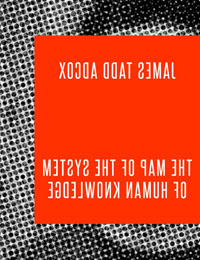 The Map of the System of Human Knowledge
The Map of the System of Human Knowledge
by James Tadd Alcox
Tiny Hardcore Press, 2012
pages / $12 Buy from Tiny Hardcore Press
While The Map of The System of Human Knowledgeis in a lot of small pieces the work can be read as one unified work. Each part is situated on the eponymous map. Formally, each small part of text is tasked with defining a specific category of human knowledge. They do this with disarming simplicity while never addressing or naming the area of the map they represent. Instead, the system of human knowledge is outlined in an oblique or affective way. Each section of the book is a discreet and important section of the map as a whole to the extent that it is revealed in the book. Each piece works as a thing itself, but the effect of the work as a whole is different, as on a map, which allows for some feeling of context and scale. A single piece presented alone does little to evoke the feeling of accumulation that occurs when progressing through the work, but each piece is touching and worth considering on its own.
In “History / Natural / Uniformity of Nature / History of Land and Sea” is in second person. The collection moves easily through points of view. Here the narrator addresses you as you hide in the bathroom from the older woman you picked up at an off season beach bar and you think:
Here salvation or transcendence shows up in a situation of kind of horrifying banality and shows itself as explicitly normal. The “how’re you getting on” is a kindly old-fashioned salutation that you can’t help but answer with a passive platitude of your vague dissatisfaction indicating nothing. It’s a weird fantasy and a weird way to take in stride communicating with this supernatural barber made of light that it works to make the situation satisfying, sad, devastating, even because it is defused. Even in the face of transcendence we’re still “Oh, you know.”
READ MORE >
August 24th, 2012 / 12:00 pm
Commuting: Have gone to Ithaca – Frank Quitely
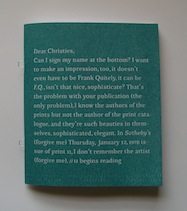 Commuting: Have gone to Ithaca – Frank Quitely
Commuting: Have gone to Ithaca – Frank Quitely
by Jared Joseph
TRNSFR / Varmint Armature Press, 2012
40 pages / $6 Buy from TRNSFR
This is a review of Commuting: Have gone to Ithaca – Frank Quitely by Jared Joseph, which is the third Chapbook from Alban Fischer and TRNSFR’s newish book arm Varmint Armature Press.
[Watch the Book Trailer here: Commuting: Have Gone to Ithaca. -Frank Quitely]
The title introduces the collection as a persona poem. Frank Quitely is the narrator. Frank Quitely is the clever inversion of “Quite Frankly”. The Frank of this work emerges in the title as a person making the journey to work. Frank is commuting to Mythical Ithaca. Everyone needs a commute, and Frank is no different. Frank Quitely is or wants to be the author of print catalogues for auction houses dealing in art like Sotheby’s and Christie’s. In the cover letter that opens the collection Frank asks Christie’s for some recognition as the one “who has wroughted”. This author character Frank is conflated and conflicted with the identity of the Jared Joseph, whose name intrudes upon the world of Frank in moments of Frankness or weakness. In Frank’s despair the world of the print catalogue collapses, and he wonders whether or not there are catalogues or prints inside them or if these are “just” poems or epigraphs to imagined pictures.
August 3rd, 2012 / 12:00 pm
